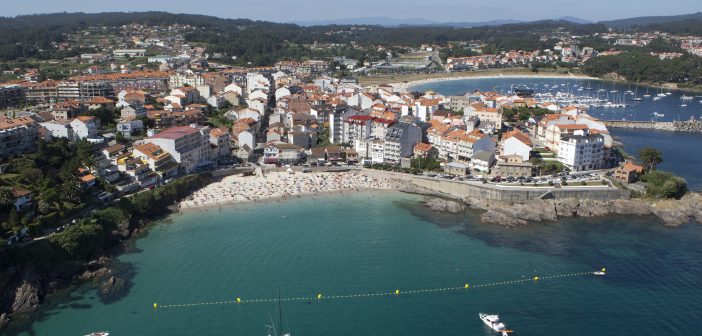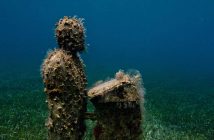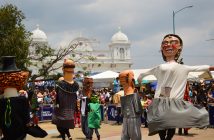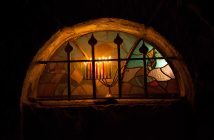Land of manors and abbeys, beaches, estuaries and pine and redwood mountains, good wine and even better seafood A land of spas and boats, smugglers and saints, the region of O Salnés in the south-west of Galicia represents the best of this coastal region set in the idyllic natural surroundings between the estuaries of Arousa and Pontevedra, in the heart of the Galician estuaries called the “Rías Baixas”. It is one of the most important tourist destinations of Galicia owing to its tourism opportunities, its multiple resources and the variety and beauty of its islands and beaches.
It’s not an easy task to mark the beginning of the route through this land full of surprises, but perhaps a good start is Cambados, capital of Albariño and centre point of the region, and there its huge square of Fefiñanes, which features a mansion with its watchtower and the church of San Benito that give life to this fantastic ensemble made entirely of granite. The beauty of the Pazo de Fefiñanes makes it one of the most lovely in Galicia, which stands out, among other things, for its arch bridge; originally there were two, but one was destroyed to make way for a road. As in so many places in Galicia, wine is bound up with the history of this palace, as it was the first place in Galicia where Albariño wine was bottled.
Not far away is the Plaza de As Rodas, where tourists and locals congregate to enjoy its tapas and wine bars and the Plaza Francisco Asorey, dedicated to the famous sculptor native to the town. Walking along the picturesque pedestrian calle Hospital you can go from the centre of Cambado to the seaside town of San Tomé, which also has a lot to show, such as the Pazo de Montesacro palace, the Tower of San Sadurniño from the 10th century and that served as an alert system for Viking incursions, the Valvaner Chapel, adjacent to the Montesacro palace or the Museum of the Fisherman’s House. Nearby is the Santa Mariña cemetery, adjacent to the ruins of the old 15th-century church with its unique Gothic charm.
Open-air art lovers should not miss the Manolo Paz Foundation museum, located just 4km from Cambados, in one of the unique landscapes of the O Salnés region, next to the Umia River estuary. Manolo Paz, a renowned sculptor, born in Cambados, exhibits his work outdoors on Tuesdays and Sundays. Appointments must be made in advance.
Beaches and spas
And since we’re talking about the sea, as is unavoidable in this region, it’s not a bad idea to take a boat and cross over to the nearby island of La Toja, in the municipality of O Grove, to which it’s connected by a nineteenth-century bridge. Here we can enjoy the island’s wonderful spas, nature, cuisine and leisure activities. Its pleasant climate means you can visit at any time of the year. Here you will find one of the most famous spas in Spain.
From the island of La Toja, you should go to the town of O Grove, which has a lot of beaches, such as La Lanzada, which is one of the largest and most popular in Galicia. Its nearly 4km of white sandy beach is bathed in the waters of the Atlantic Ocean, and the waves draw surfers from all over the world. Framing this picture postcard environment, the beach is surrounded by lush greenery and pointy rocks that jut out into the sea. The sanctuary is a pilgrimage site for infertile women, because ancient legends hold that its waters can enhance fertility. Although the best way to achieve this fertility, it’s said, is the so-called Cuna da Santa, a stone in the shape of a small bed that is believed to guarantee pregnancy, provided you copulate on it. As night falls, some people try.
The end, or the beginning, of the beach, is part of Sanxenxo, which holds the honorary title of capital of tourism in the Rías Baixas. Almost joined with Portonovo, both towns are devoted to youth, nightlife, beaches and tapas. Sanxenxo is one of the capitals of Galician tourism. Its population multiplies in summer. Before the tourism boom, it was just a small fishing village, but the constant arrival of outsiders completely transformed its appearance, with its beach and lively nightlife acting as magnets. The port of Sanxenxo is made for tourism, offering mooring possibilities, especially for shallow-draft vessels.
Holy roads
From Cambados to the north, some routes connect with the Camino de Santiago (the Way of Saint James). In the year 44, the Arousa estuary was crossed by the boat that carried the body of the apostle St. James on his way to Compostela by his faithful disciples Athanasius and Theodore.
Centuries later, another route of a religious meaning helps to discover some of the secrets of O Salnés. This is the Route of Father Sarmiento which, through vineyards, valleys and rivers, takes you into the most picturesque region you can dream of, as the Spanish writer Emilia Pardo Bazán once said. With your eyes set on the Rías de Pontevedra and Arousa, you can see the path that Fray Martín Sarmiento took in 1745 to win the jubilee. A 190km trail that runs along the beautiful coast towards Santiago de Compostela. A route full of history, nature and landscapes whose beauty will leave its mark in your memory. The Salnés is a full-fledged path on the sea. A world of contrasts between valleys and fishing villages.
Although if you want to follow the route taken by the remains of the Apostle James to Compostela, there is nothing like doing it with Alvamar. In this boat trip, you’ll sail from the waters of the Ria de Arousa to the port of Pontecesures. Just 2km away lies the village of Padrón. The route runs through the waters of the island of Cortegada. Bamio, Catoira, Valga and Dodro are some of the towns that are visible from the river and that, together with their bridges, Viking towers and crossroads will accompany those who decide to make the maritime fluvial section of the Camino, also known as the Translatio Route.
And since you’re going on boat rides in the fishing port of O Xufre, it’s worth taking the “Fishing Arts Route” excursion with the company Amare, a two-hour boat trip where you’ll get to know everything there’s to know about the world of shellfish, from how shell fishermen carry out their work and how seafood is collected, to how mussel pans work, structures for the cultivation of this mollusc that have a maximum of 500 ropes of 12m with about 350kg of mussels each. During the excursion, the guides will explain the whole process, which lasts 14 months from the moment the baby mussels are placed on the ropes until the mussels arrive at the packing machines. One peculiar fact: after the mussels are all packed, the leftover shells are used to make compost.
Returning to the mainland, the Carreirón Natural Park awaits us, a place that boasts beaches of crystal clear waters and white sandy beaches and an area of special interest for bird watching. After crossing the bridge again, we can continue on our way to the beaches of O Terrón, a coastal route that leads to the centre of Vilanova de Arousa. This municipality, which was the birthplace of the writer Ramón del Valle-Inclán, allows you to relive history by visiting his museum house. The botanical park of Enrique Valdés Bermejo will welcome you to Vilagarcía de Arousa, a city known as the Port of Compostela that opens its doors to the Vista Alegre Palace which, together with its Convent, forms an architectural complex of great value that has been declared a National Historic-Artistic Monument in Spain.
Leaving the region of O Salnés, you can see Catoira, in the midst of a landscape of forests and marshes. The Arousa estuary meets the Ulla River, creating a natural border that separates the provinces of Pontevedra and La Coruña. The West Towers recall its glorious past defending the town of Compostela. From Padrón, the route follows the Portuguese Route through Iria Flavia, Esclavitude and small rural villages in the municipality of Teo. In the distance, you can see the slender towers of the cathedral of Santiago.
Drinking… and eating too
And if all these visits whet your thirst and appetite, not to worry: you’ve come to the right place. O Salnés is a good example of the best Galician cuisine, which in turn is an authentic point of reference both in Spain and the world. It has a wide variety of native dishes, and the raw materials are of prime quality. Galicia has a deep-rooted seafaring culture, as one of the world’s leading producers of fish and seafood. Quality seafood par excellence is that which is caught on the Galician coast. Experts say that the water, temperature and waves found on these seabeds give crustaceans and bivalves a real taste of the sea, setting the standard in this sector.
Another of the stars of the region is Albariño wine, considered one of the best whites in the world. Numerous wineries produce this great wine, many of them located in mansions (“pazos”), with beautiful gardens and surrounded by vineyards where the Albariño grape is grown, which native to Galicia and with the Rías Baixas Designation of Origin. It’s an example of what Galician agriculture is all about, marked by smallholdings, with some 21,000 small production plots. It’s the expression of a land, its history, its climate and its landscape, fraught with tradition and custom.
Oenologists say that the quality of wine has its origin in the field, in the land where each vineyard is planted and not only in the work carried out by the wineries. That is why in recent decades the work and care of vineyards have proven to be essential. And in the case of the Rías Baixas, whose orography is almost par excellence a land of smallholdings, the care for the vine is meticulous and painstaking. Guided tours are available to acquaint ourselves with these estates, where all the winemaking processes are explained, with tastings that reveal the secret






